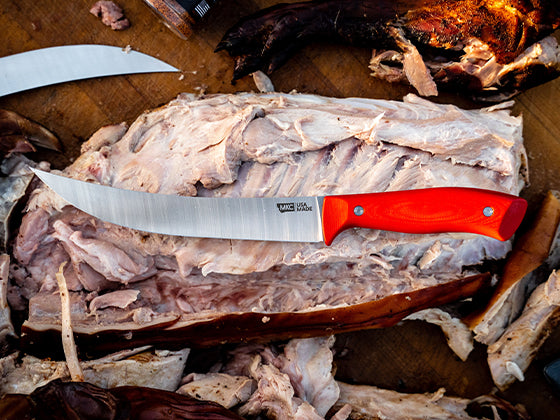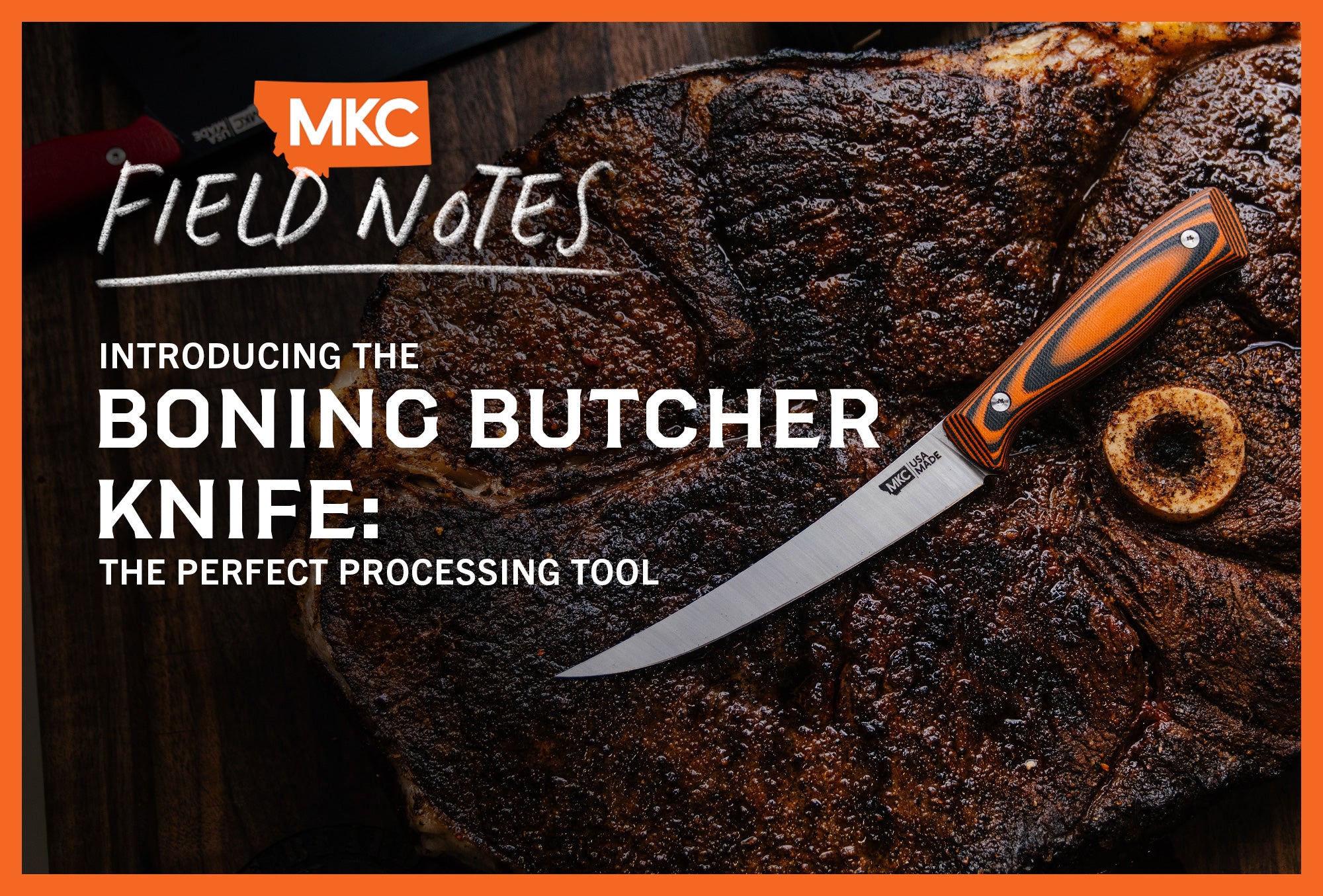A knife is simply a tool you use to complete a task. So, when choosing a knife, don’t pick the one that looks the coolest (though we are proud of how cool our knives look). Pick the one best suited for the task at hand.
A hunter rarely needs a blade for just one purpose. MKC knife owners often find themselves hunting one day and out on the job the next. For instance, one of our customers cuts hop vines for his brewery five days a week and ventures into the field on weekends.
So, which knife blade type will best suit your many needs? You have a wealth of options. Is a fixed blade or a folder more convenient? How about a drop point hunter?
We want to help you make an informed decision. Below, we’ll review 11 common knife shapes and explore each knife blade type’s strengths and weaknesses.
1. Drop Point
To me, the drop point hunter is the most useful knife blade type. It’s also the most popular knife blade style of all time.
Don’t let the name deceive you — this knife isn’t just for hunting. It’s incredibly versatile.
The drop point is called such because, as the spine emerges from the handle, it drops down to the knife’s tip. Drop point knife profiles vary, but most have a bit of belly. This shape creates strong tips that can perform a variety of tasks.
Drop points work well for skinning and gutting, and the sloping ridge helps control pitch momentum. A good drop point blade can also handle tough tasks like batoning wood.
Several of our knives use the drop point design, and there’s a reason. There’s very little this knife can’t do.
2. Trailing Point
A trailing point knife has a spine that emerges from the handle and goes up. Since the tip rises above the spine, this knife blade type has a lot of edge geometry.
Use a trailing point knife for tasks like filleting, slicing, or skinning — anywhere you need long, smooth cuts. While trailing points have a good tip on them, it’s located up and out of the way, so they’re not suited for prying.
Their nonstandard shape means the tip isn’t as sturdy as a drop point. On trailing point blades, the long cutting edge does all the work.
I wouldn’t recommend this knife blade type for tasks that require a lot of tip work. It also wouldn’t be a good choice for self-defense or gutting. However, it’s great for skinning and filleting.
3. Hawkbill
As the name implies, the hawkbill (aka the talon) resembles a bird of prey’s beak or talon. The edge dives off aggressively, and the tip is below the cutting edge. It’s similar to a wire skinning knife a lineman or an electrician might use.
This knife type is suitable for jobs that require aggressive pulling action. If you cut boxes in a warehouse all day, this blade effortlessly rips through tape and cardboard.
Hawkbill knives also work well for cutting and removing carpet. If you’re a flooring installer by trade, having one on hand is a no-brainer.
The hawkbill’s hooked shape also lends itself well to cutting ropes, vines, and twigs. The downward-facing point helps the blade grip onto your target instead of sliding off.
However, the hawkbill is a utility knife through and through. It lacks a drop point blade’s versatility for hunting, processing, and skinning.
It’s also worth noting that while the hawkbill is a hooked blade, it’s not the same as a gut hook.
4. Gut Hook
The gut hook isn’t exactly a knife blade type, but it’s worth mentioning since we get asked about it often. It’s a backward hook with a sharpened edge, often milled into a knife’s spine.
Gut hooks have one purpose: gutting. Use it in field dressing to get under your game’s hide without poking into the gut cavity.
Outside of that one task, the gut hook has very few uses. The hooked design often gets in the way more than it helps. It can be dangerous if you don’t keep it sheathed, as it can snag on clothing and brushes.
If you need a gut hook, carry one by itself instead of on your knife. Dedicated gut hooks are small, compact, and easy to carry in your pack. Many manufacturers even skeletonize them to keep them as light as possible.
Keep an eye out for multi-tool-style gut hooks with other attachments included. They give you a little more bang for your buck.
A good skinning technique goes a long way in a gut hook’s absence, too. With enough practice, you can skin an animal without worrying about a puncture, even with a skinning knife alone.
5. Sheepsfoot / Wharncliffe
Sheepsfoots and Wharncliffes are similar at first glance, but these knife blade types have key differences.
A Wharncliffe curves at the handle. From there, the spine slowly and continuously dives off to the point where it meets the straight-line cutting edge. Its fine tip is great for delicate tasks.
On a sheepsfoot, the spine starts straight, then curves progressively down to the tip. Some sheepsfoot knives have a sudden curvature closer to the end of the knife. It has a straight edge, just like the Wharncliffe, but with a stronger, thicker spine that results in a heavier blade.
Farmers originally designed the sheepsfoot to trim sheep’s hooves. For that job, you wouldn’t want a point that could harm the sheep if it moved. As such, this knife blade type has a small and blunt yet strong tip.
Meanwhile, the Wharncliffe has a large but weak tip.
The sheepsfoot is especially useful for tradesmen who need a knife that can pry. The stronger tip means it can handle those jobs without taking a beating. A painter by trade, for example, might keep a bulky sheepsfoot on hand to open paint cans in a pinch.
6. Tanto
The tanto knife is an incredibly popular blade design with roots in Japanese sword culture. It’s an angular knife that excels in self-defense scenarios.
The tanto knife’s spine is straight. The edge stays straight almost to the end of the knife, where it angles dramatically toward the tip.
Because of its aggressive shape and strength, the tanto is great for piercing, stabbing, and self-defense. Its sharp angle also helps it excel at prying and scraping tasks. It works well for shucking oysters, separating stuck parts, and scraping off old adhesive or paint.
Those tasks aside, this knife blade type doesn’t offer a lot of use. It’s not something you’ll see a farmer, rancher, or lineman carrying in the field, as its unique shape is often a hindrance.
Tantos are difficult to sharpen. Because the blade takes a ton of abuse where it angles toward the spine, the tip dulls faster than the rest. However, you lose that sharp angle when you sharpen just that area.
While aesthetics aren’t everything, losing that distinctive angular curve can be disheartening. The tanto makes a half-decent utility knife, but there are more functional blades out there.
7. Reverse Tanto
The reverse tanto is the tanto’s mirror image. The blade design features a straight spine with an angular transition to a strong blade tip. It often has a larger belly than a standard tanto.
The reverse tanto is a popular knife blade type for folding knives. It has a nice, strong point and an edge designed for continuous cutting. It’s useful for everyday tasks like opening boxes and cutting rope.
Unlike its fraternal twin, the reverse tanto isn’t very good at piercing and stabbing. If you don’t need to pierce or stab, it’s quite useful.
8. Clip Point/Bowie Knife
One of my favorite knife blade types is the clip point, also called the Bowie knife. The Bowie got its name from Alamo fighter James Bowie, who used it in hand-to-hand combat.
This knife blade design has a traditional frontiersman look and a fairly straight spine. The top third of the blade looks like someone clipped it off. The shape can be concave or straight and angular, and the tip comes to a fine point.
Clip point knives work well for piercing and stabbing, but because of the blade’s extra width and dimension, it’s robust enough for chopping, too.
Unfortunately, this knife blade style’s fine tip isn’t great for prying. It’s useful for getting into small spaces but doesn’t have the strength to pry from there. Because of this, many older Bowie knives are missing the tip.
9. Kukri
A kukri’s large blade is narrow at the handle and aggressively curves downward as it widens. This knife blade type has a nice recurved edge and a wide, sweeping belly. While most come in large, machete-like sizes, you can also find them as folding knives.
Kukri knives are fantastic for chopping. It traps whatever material strikes the edge behind the belly. Then, as you pull through what you’re chopping, the belly adds force and extra cutting power.
Depending on the design, kukri knives can also have strong, functional tips.
Kukris are large knives suited for big tasks. They’re fun to own and use. If you’re interested in purchasing one, Jason Knight designs some of the best we’ve seen.
10. Dagger
The classic dagger is one of my favorite custom knife types to make.
A dagger is a symmetrical knife with a double edge. It comes in many shapes and sizes, all suited to different tasks. Some have a blunt tip, while others thin out to a needlelike point.
For knife makers, a dagger is a challenge. Symmetry is difficult to achieve when making a knife by hand. Your chance of becoming a master bladesmith hinges on your ability to craft a good, symmetrical dagger.
Daggers are great for piercing and stabbing. In fact, that’s about all they’re good for, aside from looking badass.
Not a lot of jobs require a dagger — it’s especially useless for any task where you’d need to leverage weight against the back of the knife — and in inexperienced hands, it’s dangerous because of its double edge.
11. Push/Punch Dagger
Last up is the push dagger, or punch dagger. Its colorful history makes it one of the coolest knife blade types.
In the card-playing days of the Old West, men would turn in their guns at the saloon door. They still wanted some self-defense, though, so they’d stash a push dagger in their vest just in case. During a fight, they’d draw the dagger and hold it in their fists with the blade between their fingers, Wolverine-style.
Unfortunately, the push dagger is only useful for punching and concealed self-defense. Unless you’re looking to defend your honor against a two-bit swindler with an ace up his sleeve, this knife is more for aesthetic purposes.
Knife Blade Types: Final Thoughts
Every knife blade has its intended purposes and best-suited tasks. Some excel at just one task, while others are more well-rounded and can handle anything the field throws their way.
It all depends on your job. For example, if you’re a whittler by trade, you might want a blade crafted for that purpose. However, if you just dabble, a general-purpose blade would do the trick.
So, how many blades do you want to carry when you’re out in the field or on the job? Are you a bushwhacker who needs a large kukri knife to cut through weeds? Are you a rancher or farmer who needs a sturdy, all-purpose sheepsfoot that can handle any cutting or prying task? Are you a collector who wants one of every knife blade type?
It’s especially important to optimize your blade arsenal as a hunter. After all, if you’re an ultralight packer, carrying a blade for every job will weigh you down. You might prefer to bring one all-rounder rather than a dedicated knife for every task.
Experiment to see what works best for you. The decision is yours.
by Josh Smith, Master Bladesmith and Founder of Montana Knife Company






































